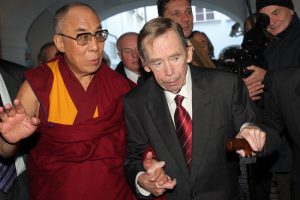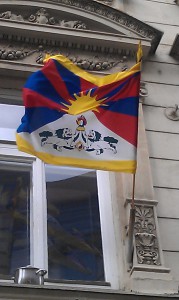Czech town halls and Tibetan flags
By by Tracy A. Burns
Czech town halls and Tibetan flags
 Tibetan flags fluttered from Czech town halls throughout the country on March 10, 2012, as the nation showed its support for Tibet and human rights on the anniversary of the brutal and bloody 1959 Tibetan uprising against the Chinese occupation. Some town halls, such as those in the major cities of Ostrava and Hradec Králové, refused to display the Tibetan flag during the annual international event called “Flag for Tibet” because they feared repercussions from the Chinese. In fact, Ostrava did not participate in the protest for the third consecutive year. The Czech Republic has had strong ties with Tibet as former Czech and Czechoslovak president Václav Havel was a strong supporter and admirer of the Dalai Lama and had even invited him to Forum 2000 conferences, which Havel helped found. At the Forum 2000 events, participants discuss topics pertaining to human rights, democracy, and the prevention of religious, cultural, and ethnic conflicts. The very respected Havel, whose admiration for the Dalai Lama reinforced Czech interest in the distant country and its leader, met with the Dalai Lama in Prague shortly before the Czech playwright and politician’s death last December.
Tibetan flags fluttered from Czech town halls throughout the country on March 10, 2012, as the nation showed its support for Tibet and human rights on the anniversary of the brutal and bloody 1959 Tibetan uprising against the Chinese occupation. Some town halls, such as those in the major cities of Ostrava and Hradec Králové, refused to display the Tibetan flag during the annual international event called “Flag for Tibet” because they feared repercussions from the Chinese. In fact, Ostrava did not participate in the protest for the third consecutive year. The Czech Republic has had strong ties with Tibet as former Czech and Czechoslovak president Václav Havel was a strong supporter and admirer of the Dalai Lama and had even invited him to Forum 2000 conferences, which Havel helped found. At the Forum 2000 events, participants discuss topics pertaining to human rights, democracy, and the prevention of religious, cultural, and ethnic conflicts. The very respected Havel, whose admiration for the Dalai Lama reinforced Czech interest in the distant country and its leader, met with the Dalai Lama in Prague shortly before the Czech playwright and politician’s death last December.
The Festival for Tibet
 Some Czech towns showed enthusiastic support for Tibet. Perhaps Tibet’s yearning for freedom resonates with Czechs because the Czech lands were considered part of the Austro-Hungarian Empire for so many centuries, and Czechs had their own desire for independence. The Festival for Tibet was launched in Lanškroun on March 7, as the Tibetan flag flew over the main square. The festival featured three films about Tibet. One short movie, dating from 1965, highlighted the support of religious organizations for Tibetans in exile. The film also emphasized the serious health ailments that the exiled are suffering and how those in exile attempt to preserve Tibetan culture. Handmade items by exiled Tibetans were on sale, too.
Some Czech towns showed enthusiastic support for Tibet. Perhaps Tibet’s yearning for freedom resonates with Czechs because the Czech lands were considered part of the Austro-Hungarian Empire for so many centuries, and Czechs had their own desire for independence. The Festival for Tibet was launched in Lanškroun on March 7, as the Tibetan flag flew over the main square. The festival featured three films about Tibet. One short movie, dating from 1965, highlighted the support of religious organizations for Tibetans in exile. The film also emphasized the serious health ailments that the exiled are suffering and how those in exile attempt to preserve Tibetan culture. Handmade items by exiled Tibetans were on sale, too.
February self-immolation
As recently as late February 2012, an 18-year-old monk set fire to himself in protest against the Chinese oppression in Tibet, an act reminiscent of Czech student Jan Palach’s January 1969 self-immolation, sparked by Palach’s dissatisfaction with the severe normalization measures in Communist Czechoslovakia. Since last spring more than 20 Tibetans, including monks and nuns, have self-immolated themselves in protest against Chinese oppression. In February China banned foreigners from visiting Tibet until the end of March 2012 in anticipation of riots and protests during the Tibetan New Year celebration and the anniversary of the 2008 Tibetan uprising.
The violence before March 1959
“The Flag for Tibet” event is a reminder of the March 10 anniversary of the 1959 Tibetan uprising, when the Tibetans rebelled against the Communists in Tibet’s capital. The violence started way before 1959, however. In response to the uprisings of June 1956, the Chinese army beat and starved prisoners as well as raped their wives in the presence of the incarcerated in Kham during 1957. The Chinese also ordered monks and nuns to copulate with each other before torturing and murdering them.
March 10, 1959, and the aftermath of the bloodshed
By February 1959 the rebels were fighting in full force. On March 10, 1959, the Dalai Lama, at the request of the Chinese army, was to attend a theatrical performance. The Chinese insisted that they alone would provide security for the Dalai Lama. The uprising was triggered when demonstrators, worried that the Chinese were going to kidnap the Dalai Lama, gathered outside the Dalai Lama’s residence in Lhasa to prevent him from going to the theatrical event. Although rebels in the capital declared Tibet’s independence, the Chinese voiced their harsh disagreement by firing shots in close proximity to the Dalai Lama’s palace, convincing the Dalai Lama to go into exile. The Chinese were no match for the Tibetans, who were defeated during two days of fighting. The Tibetan government-in-exile stated that as many as 87,000 Tibetans may have lost their lives during the uprising. The Chinese publicly executed the Dalai Lama’s bodyguards in the capital. Thousands more were killed, and many monasteries and temples were damaged beyond repair.
Unrest in March 2008
The Tibetan unrest in March of 2008 involved riots, protests, and demonstrations as well as looting, burning and killing during the anniversary of the 1959 Tibetan uprising. Protestors set fire to businesses owned by the Chinese and demolished shops and restaurants. The Chinese responded by using tear gas, sending in 4,000 troops, beating monks, and shooting demonstrators. The riots spread to other parts of Tibet, and protestors around the world unleashed their anger by attacking Chinese embassies. From the beginning of the uprising in March to April of 2008, hundreds lost their lives, and thousands were arrested, according to the government-in-exile.
The Czech Republic’s reaction
The Czech Republic reacted to the bloody events by stating that violence was not the solution, demanding that the Chinese halt repressions at once, and by arguing that the arrested Tibetans should be released. The Czech government also favored allowing journalists into Tibet.
Few Olympic boycotts
Although China blamed the Dalai Lama for sparking the riots, the Tibetan bloodshed did not cause many boycotts at the Olympic Games in Beijing that same year. Leaders of more than 80 countries attended the opening ceremonies while Polish Prime Minister Donald Tusk was the only European head of government to boycott the inaugural ceremonies.



